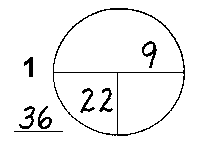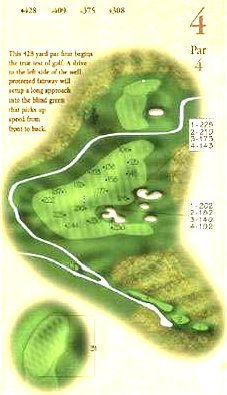Golf Instruction Article |
|||||||
Pin Sheets and Yardage Books
|
 |
Pin Sheet Example |
A basic pin sheet usually includes the following information besides the hole-number (which is the "1" in our example illustration to the right). Distances are commonly measured in paces, which I guess you could either call yards or meters -- to get more precise than that, if you felt like you needed to, you could use a range finder of some kind (see illustration).
- The total depth of the green (the "36" in our example illustration)
- The distance (depth) of the hole from the front of the green (the "22" in the illustration, meaning that the pin is 4 paces deeper than the center of the green in this case)
- The distance of the hole (laterally) from the green's closest edge ("9" paces from the right edge of the green in the illustration)
Once you know the depth of the pin placement into the green you can either add or subtract the appropriate number of paces (or yards or meters) from the center of the green -- depending on whether the cup is cut more toward the front or the back of the green -- to get your yardage to the hole. In our example illustration, since the total depth of the green is 36 paces the center of the green is at 18 paces. So whatever yardage you arrive at based on the yardage markers, plus or minus any necessary pacing that you had to do to the location of your ball, the actual yardage to the hole would be 4 yards more than that.
Pin sheets occasionally come in more polished varieties too. Some golf courses have printed pin sheets in all their golf carts.
Of course, pin sheets only actually matter to players at a high enough skill level to have control over their distances. For most players knowing the yardage to the center of the green is enough.
Yardage Books
 |
Yardage Book Example |
You may have seen yardage books that some golf courses provide to give more detailed information about each hole, beyond just the raw yardages as marked on the scorecards, tee plates, sprinkler heads or other types of markers. Yardage books like this come in a variety of thoroughness and slickness. But it is also possible to make your own yardage book. And when you see the professionals on TV consulting the little pocket-sized notebooks -- typically carried in a back pocket for handy access -- that is what you're seeing: a self-made yardage book containing not only yardages but probably much more in-depth information about the playing characteristics of each hole. A player and his caddy may both have copies of the same book in some cases.
Now you might be thinking, "Isn't the golf course already full of yardage markers all over the place?" And the answer may be yes, but a given player may want to have even more yardages from different locations or add notations about situations where yardages "play" differently than marked (e.g., due to elevation changes, subtle prevailing wind, etc.). A player might even keep notes on previous experiences on a hole to refresh their memory.
Some examples of possible notations in a yardage book
- The slope of a green or fairway
- The firmness or softness of a green or fairway, particularly when it differs from the majority of the rest of the golf course
- A yardage to carry or stay short of a fairway bunker or other landmark
- A yardage from a particular tee marker to the end of the fairway in a particular direction (so as to know the maximum distance the ball can go off the tee and still stay in the fairway)
- If a green is irregularly shaped how far it is to carry to, or stay short of, different edges of the green
- If there are multiple tiers, or false fronts or backs, on a green how far it is to carry to, or stay short of, each section
Pin sheets and yardage books both provide more detailed information about the holes on a golf course. But, again, they only matter if you have the skill to control your ball well enough to make use of them. To develop your skill I recommend my short series of paperback golf instruction books covering the entire game and working with me in person if you are near, or traveling to, the bay area of San Francisco in Northern California.
* In rare instances a particular course may provide their yardages to the front edge of the green rather than to the center, but yardages are most commonly measured to the center.
![]()
 |
 |
It is generally the case that in order to improve in any area of the game you'll need the feedback of an experienced and reputable professional golf instructor. If you anticipate traveling to the bay area of San Francisco in Northern California, contact me to set up a Private Golf School or a golf lesson.
If coming to work with me in person is not possible get my books.
Related Content
Golf Instruction (in-person) - Private Golf SchoolGolf Book - Beyond the Basics
GPS Range Finder
Pro Scope Range Finder
Golf Instruction Articles - various
Ask the Pro - Pro golf-related Questions & Answers
Ask the Pro - Course-related Questions & Answers
For more golf instruction articles see my
archive of previous golf instruction articles.
Feel free to send me a message to suggest a topic for future articles.
